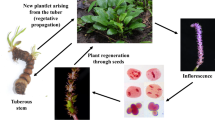Abstract
The meioses of four sterile species in the genusAllium which develop bulblets in the inflorescences instead of seeds were compared, namelyAllium sativum, A. cepa var.viviparum, A. carinatum, andA. oleraceum. The most important of them,A. sativum, is an ancient cultivated plant and its vegetative reproduction prevents it from more rapid evolution such as is known in generatively propagated cultivated plants.A. sativum shows fully normal meiosis. After the disintegration of the tetrads, however, the blockade of 1. pm takes place. The cause of the blockade has not yet been cleared up. Removing of bulblets appeared as having no influence on the development of microgones. It is assumed that there may be a viral phenomenon causing a disease of the tapetum without disturbing other functions. InA. cepa var.viviparum there was observed a heavy aberration disturbance in the meiosis, which had already been signalled by the mitosis. On this ground 1. pm does not occur and sterility is fully justified. The aberration disturbance does not seem to spoil the vegetative development but on the contrary to give it a vigorous character.A. carinatum andA. oleraceum are triploid and tetraploid forms; in the meiosis they form various configurations—univalents, bivalents, trivalents, and quadrivalents. The following irregular chromosome distribution results in the coming into existence of variously valuable gametes. 1. pm takes place. There is a theoretical possibility of generative reproduction (after the extirpation of bulblets).
Abstract
Byly srovnány meiose čtyř sterilních druhů roduAllium, u kterých se místo semen vyvíjejí v květenstvích viviparní cibulky:A. sativum, A. cepa var.viviparum, A. carinatum aA. oleraceum. Nejdůležitější z nich,A. sativum, je stará kulturní rostlina a vegetativní reprodukce brání v rychlejší evoluci, jak ji známe u generativně množených kulturních rostlin.A. sativum vykazuje plně normální meiosis. Po rozpadu tetrad však nastává blokáda 1. pm. Příčina blokády není objasněna. Odstranění viviparních cibulek neovlivňuje vývoj mikrogonů. Je vyslovena domněnka, že může jít o virový fenomén způsobující chorobu tapeta, aniž by byly narušeny jiné funkce, nebo o metabolickou poruchu tapeta.
UA. cepa var.viviparum byla shledána v meiose těžká aberační porucha, která už byla signalizována mitosou. K, 1. pm z uvedených důvodů nedochází a sterilita je plně zdůvodněna. Aberační porucha zřejmě nenarušuje vegetativní vývin, ale naopak dává vigorní charakter. UA. carinatum aA. oleraceum jde o triploidní a tetraploidní formy; v meiose se vytvářejí různé konfigurace—univalenty, bivalenty, trivalenty a quadrivalenty. Následné nepravidelné rozdělení chromosomů má za následek vznik různě hodnotných gamet. 1. pm. probíhá. Teoreticky je dána možnost generativní reprodukce (po extirpaci pacibulek).
Similar content being viewed by others
Literatur
Ascherson, P., Graebner, P.: Synopsis der mitteleuropäischen Flora. Bd. 3.—Leipzig 1905.
Battaglia, E.: Mutazione cromosomica e cariotipo fondamentale inAllium sativum L.— Caryologia16: 1–46, 1963.
Brewbaker, J. L.: Angewandte Genetik.—Gustay Fischer Verlag, Stuttgart 1967.
Hegi, G.: Illustrierte Flora von Mitteleuropa.—J. F. Lehmann's Verlag, München 1906.
Helm, J.: Die zu Würz und Speisezwecken kultivierten Arten der GattungAllium L.—Kulturpflanze4: 130–180, 1956.
Hrubý, K., Konvička, O.: Polní pokusy. [Feldversuche.]—Olomouc 1954.
Jinks, J. L.: Extrachromosomale Vererbung.—Gustav Fischer Verlag, Stuttgart 1969.
Khoshoo, T. N., Atal, C. K., Sharma, V. B.: Cytotaxonomical and chemical investigations on the north west Indian garlics.—Res. Bull. Panjab Univ. (N.S.)11: Parts I-II: 37–47, 1960.
Koul, A. K., Gohil, R. N.: Causes averting sexual reproduction inAllium sativum Linn.— Cytologia35: 197–202, 1970.
Levan, A.: Zahl und Anordnung der Chromosomen in der Meiosis von Allium.—Hereditas13: 80–86, 1929.
Levan, A.: Cytological studies inAllium. A preliminary note.—Hereditas15: 347–356, 1931.
Levan, A.: Cytological studies inAllium, II.—Hereditas16: 257–294, 1932.
Levan, A.: Cytological studies inAllium, III.—Hereditas18: 101–114, 1933.
Levan, A.: Cytologische Studien anAllium schoenoprasum.—Berlingska boktryckeriet, Lund 1935.
Mensinkai, S. W.: Cytogenetic studies in the genusAllium.—J. Genet.39: 1–45, 1939.
Němec, B.: Dějiny nejdůležitějších rostlin kulturních. [Geschichte der wichtigsten Kulturpflanzen]. —Praha 1908.
Author information
Authors and Affiliations
Additional information
Address: Sokolovská 6, Olornoue, Tschechoslowakei.
Rights and permissions
About this article
Cite this article
Konvička, O. Cytotaxonomische Studien von vier sterilen Arten der GattungAllium . Biol Plant 14, 62–70 (1972). https://doi.org/10.1007/BF02920903
Received:
Published:
Issue Date:
DOI: https://doi.org/10.1007/BF02920903




